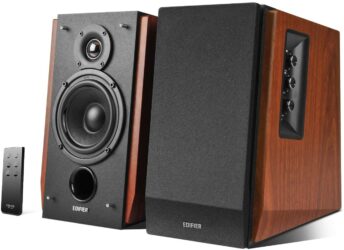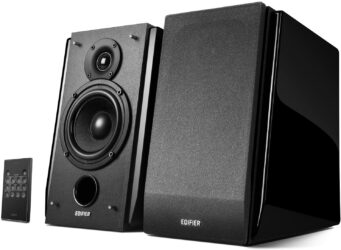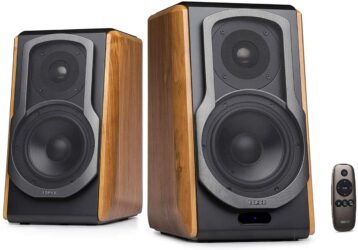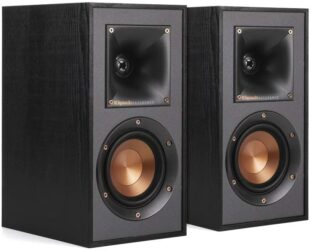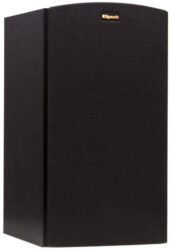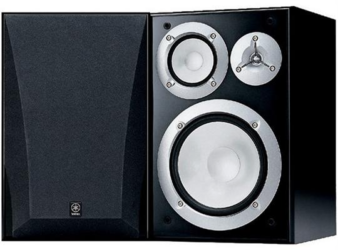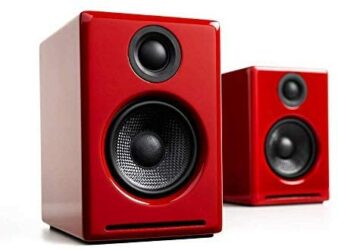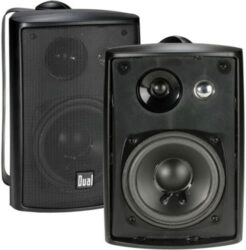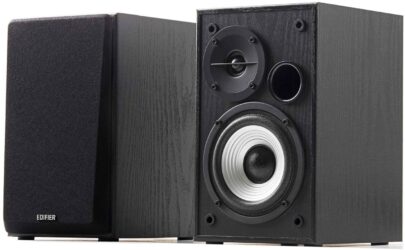Having a quality set of speakers can make your music come alive and transform your music into an unforgettable experience. But properly setting up a quality sound system requires a lot of due diligence, especially when you’re on a limited budget. One of the best ways to balance budget and performance is by investing in a set of bookshelf speakers, which offer high-performance audio at a price and size far less than an all-out speaker system.
If you’re looking to add a set of bookshelf speakers to your setup, but find the number of choices overwhelming, there’s no need to fret. We’ve put together a list of the best budget bookshelf speakers we’ve found to help you make the right choice, no matter your budget.
- Buying Budget Bookshelf Speakers
- Top 10 Best Budget Bookshelf Speakers 2025
- 1. Best Overall Bookshelf Speakers: Edifier R1700BT Bluetooth Bookshelf Speakers
- 2. Best Low-Range Bookshelf Speakers: Edifier R1850DB Active Bookshelf Speakers
- 3. Best Mid-Range Bookshelf Speakers: Edifier S1000DB Audiophile Active Bookshelf Speakers
- 4. Best High-Range Bookshelf Speakers: Klipsch R-41M Bookshelf Home Speakers
- 5. Best Bookshelf Speakers for Big Amplifiers: Klipsch R-15M Bookshelf Speakers
- 6. Best Oversized Bookshelf Speakers: Yamaha NS-6490 Bookshelf Stereo Speakers
- 7. Best Home Theater Bookshelf Speakers: Polk Audio T15 100 Watt Home Theater Bookshelf Speakers
- 8. Best Bluetooth Bookshelf Speakers: Audioengine A2+ Wireless Speakers
- 9. Best Outdoor Bookshelf Speakers: Dual Electronics LU43PB 3-Way Speakers
- 10. Best Computer Bookshelf Speakers: Edifier R980T Active Bookshelf Speakers
- Bookshelf Speaker FAQ
- Everything You Need to Know About Budget Bookshelf Speakers
- For Those About to Rock (We Salute You)
Buying Budget Bookshelf Speakers
When it comes to speakers, there are a ton of factors to keep in mind. For the sake of brevity, we’ll only cover some of the most important factors you should consider in bookshelf speakers.
Wattage
When you’re considering the right set of bookshelf speakers, you’ll want to factor in the wattage. There’s a common misconception that speakers with higher wattage will be louder than lower wattage speakers. While this is untrue, you do need to keep wattage in mind.
There are two different types of wattage to consider – RMS wattage and peak wattage.
RMS Wattage
A root mean square (RMS) wattage rating, put simply, is the average continuous wattage a speaker can handle from an amplifier without sustaining damage. This number is typically half the total peak wattage, and is generally the most important number to consider when looking at wattage.
Peak Wattage
Peak wattage is the total number of watts a speaker can handle in short bursts without sustaining damage. This number is typically at least twice the wattage as the RMS rating (though it varies by speaker). When you hook speakers to an amp that’s capable of putting out a higher wattage than the speakers can handle, you run the risk of blowing your speakers.
Sensitivity
Now that we’ve ruled wattage out of the loudness equation, you might be wondering how to actually determine the perceived loudness of a speaker. The answer is actually kinda complex, but to quickly summarize, it’s the number of decibels a speaker will put out at a given power rate. The higher the sensitivity rating a set of speakers has, the louder they’ll get from a given power level.
Sensitivity ratings are typically expressed in one of 2 ways: 1W/1M or 2.83v/M. For each of the given power units (1W or 2.83v), a speaker will put out X decibels. Just remember that decibels are logarithmic, not linear, so a 90dB speaker is 10 times louder than an 80dB speaker.
Passive vs Active
When it comes to speakers, there’s yet another choice you have to make: active or passive?
Passive Speakers
Passive speakers are the type of speakers you see in many home theater setups. They have only one set of wires running to each speaker (speaker wire) and hook into an amplifier. Active speakers, on the other hand, have built-in amplifiers. Both types of speakers have their advantages and disadvantages over one another.
Passive speakers allow for less wiring, making them easier to place. In addition to allowing for more versatile placement, they also offer the ability to pair them with any amp you choose. They also compartmentalize failure and upgrades. This means if your amp or speaker dies, or you want to upgrade them, you can do so without replacing more than what’s necessary.
Keeping this in mind is important when buying speakers. If you’ve already got an amp, and you’re looking to add on to your sound system, then you’ll likely want to go with something passive like the Klipsch R-15M Bookshelf Speakers.
Active Speakers
Meanwhile, active speakers are more of an all-in-one solution. They allow for greater portability, offering a direct connection from your audio device to the speakers without an external amp. Their built-in amplifiers are also the most optimal pairing with the speaker itself, meaning you won’t have to match wattage ratings and the like, or worry about overpowering the speakers with the amp.
However, if you’re just getting started and need a good set of speakers to play your music, then you might want to consider active speakers. Something like the Edifier R1700BT Bluetooth Bookshelf Speakers are a good choice for most, balancing range, sound, and budget the best out of all the speakers we’ve found.
Size
Don’t let anyone tell you otherwise: size matters. There are two reasons you’ll want to pay attention to the size of the speakers you’re buying.
One is because the size of the speakers can impact the sound and tones you’re going to get out of your speakers. Different sized speakers mean different size drivers, which directly impacts their ability to effectively push varying frequencies.
The second reason is more practical – planning. Whether you intend to stick your speakers on a desk or place them on dedicated stands, you’ll want to know how big they are, so you can fit them into your setup accordingly.
Bluetooth Connectivity
In today’s wireless world, it’s common to find bookshelf speakers with Bluetooth connectivity. If you want the convenience of streaming your audio to your speakers without a wire, you’ll want to make sure the speakers you choose have Bluetooth onboard. The Audioengine A2+ Wireless Speakers are perhaps the best set of Bluetooth speakers we’ve found, equipped with aptX-HD and Bluetooth 5.0 for low-latency audio streaming.
Just keep in mind that you’ll lose some audio quality when streaming your music via Bluetooth.
Now that we’ve covered some of the most important aspects of bookshelf speakers, let’s look at the best budget bookshelf speakers we’ve found.
Top 10 Best Budget Bookshelf Speakers 2025
1. Best Overall Bookshelf Speakers: Edifier R1700BT Bluetooth Bookshelf Speakers
Why we like it:
These speakers sound good and blend useful features together really well for their price.
Quick Specs:
- Wattage:66w peak (33w RMS)
- Sensitivity:n/a (85 dB)
- Speaker type:Active
- Size:6.1”w x 10”h x 8.4”d / 4” driver
- Bluetooth:Yes
- Sound sample:Youtube
The 1700BTs are a great set of standalone speakers, featuring a great blend of sounds for lows, mid’s, and highs. They go loud without washing out, and have separate bass, treble, and volume adjustments that allow for fine-tuning adjustments tailored to your needs.
With two RCA ports and built-in Bluetooth, they also offer a reasonable amount of connectivity and work well with any Echo device for Alexa compatibility. The included remote is also a nice touch, and since they’re active speakers, they’re a great choice for any room and setting in your home, from your living room to your bedroom.
The only major problem with these speakers is that sometimes the Bluetooth stays on, even when the speakers are powered off. This is quite concerning, but you can remedy this easily by keeping them paired to your phone or another Bluetooth device, even if you don’t use Bluetooth.
If you really can’t live with the always-on Bluetooth functionality, you might consider the Edifier R1850DB, which don’t have this issue. However, keep in mind they’ll cost you more than these, making these the superior choice if you’re budget-conscious.
The 1700BTs may not be perfect, but they do an excellent job of blending sound quality, power, connectivity and budget. If you’re looking for a good set of standalone bookshelf speakers without breaking the bank, you can’t go wrong with these.
Pros
- 2-year warranty
- Separate bass and treble adjustments
- Alexa compatibility
- Comes with a remote
Cons
- Bluetooth always on
2. Best Low-Range Bookshelf Speakers: Edifier R1850DB Active Bookshelf Speakers
Why we like it:
These speakers offer impressively deep and rich bass tones for bookshelf speakers, and come at an affordable price.
Quick Specs:
- Wattage:70w peak (16w + 19w RMS)
- Sensitivity:n/a (85 dB)
- Speaker type:Active
- Size:5.74”w x 9.48”h x 7”d / 4” driver
- Bluetooth:Yes
- Sound sample:Youtube
One of the biggest problems with bookshelf speakers is that many lack an adequate bass output for low frequencies. However, the Edifier R1850DB Active Bookshelf Speakers are an exception. These bad boys impressively push out sound and have front-facing ports to move air to really help them boom.
This is because these are actually bi-amp speakers, meaning there’s a dedicated amp for low frequencies, resulting in deeper and richer bass tones. And if they don’t boom enough for your liking, they also come with a subwoofer out port, so you can attach a subwoofer directly to the speakers.
These speakers offer multiple input connection methods, including optical input and Bluetooth. They also come with a handy remote, and you should be able to pair them with your regular TV remote, making them a great addition to your living room. They also come with a 2-year warranty.
Now, while these speakers are great for low-end frequencies, they lack in their mid and high-range frequencies. For mid-range, you might consider the Edifier S1000DBs, and the Klipsch R-41M is great for high-range frequencies. However, keep in mind both sets of speakers offer a steep jump in price compared to these.
If you’re looking for a good set of bookshelf speakers that have enough bass to not absolutely require a subwoofer, then you’ll definitely want to give these speakers a chance.
Pros
- Bi-amp design for deeper bass
- Subwoofer output port
- Many input connection methods
- 2-year warranty
Cons
- Lack in mid-range and high-range frequencies
3. Best Mid-Range Bookshelf Speakers: Edifier S1000DB Audiophile Active Bookshelf Speakers
Why we like it:
Another great set of speakers from Edifier, they produce detailed sound for any type of music with an excellent mid-range.
Quick Specs:
- Wattage:240w peak (120w RMS)
- Sensitivity:n/a (85 dB)
- Speaker type:Active
- Size:8”w x 13.5”h x 10.5”d / 5.5” driver
- Bluetooth:No
- Sound sample:Youtube
When listening to music, you want a set of speakers that can deliver a full range of sounds. The Edifier S1000DB Audiophile Active Bookshelf Speakers do just that, and they do it well.
These speakers are robust and heavy-duty with an emphasis on heavy, lending credence to their solid construction. These little powerhouse speakers pack a big punch and balance all different sound ranges well with crisp highs and tight bass. But where they really stand out is the mid-range, handling vocals and the crucial portion of the mix very well.
The S1000DBs come with multiple modes of connectivity, including aptX Bluetooth for high-quality, low-latency wireless audio output. Coupled with the remote, Alexa compatibility, and their intense output, they’re great for your living room.
While these speakers are truly a great set of speakers, they do have a couple of glaring flaws. First, they don’t have a physical mode switch on the speakers, meaning you won’t want to lose the remote if you plan to use them with more than one device.
They also don’t have a subwoofer output jack, meaning you’ll have to find another way to hook them up to a subwoofer if you find the bass lacking. Obviously not all the speakers we’re recommending have this, but at their relatively high price, they really should allow you to tailor them to your specific needs without a DIY workaround. If you absolutely can’t live without a sub, we’d recommend choosing something more expandable like the 2.1-capable Polk Audio T15 100 Watt Home Theater Bookshelf Speakers.
Overall though, these speakers are an excellent choice if they fall within your budget. If you want a set of speakers that really shine on the mid-range, and you can look past their flaws, it’s hard to go wrong with these.
Pros
- Heavy-duty construction
- Great mid-range sound
- aptX Bluetooth
Cons
- Mode switching requires the remote
- No subwoofer output
4. Best High-Range Bookshelf Speakers: Klipsch R-41M Bookshelf Home Speakers
Why we like it:
These high-end speakers play high-range audio very nicely, and they look fantastic without their covers on.
Quick Specs:
- Wattage:200w peak (50w RMS)
- Sensitivity:90dB 1W/1M
- Speaker type:Passive
- Size:5.75”w x 11.3”h x 7.9"d / 4” driver
- Bluetooth:No
- Sound sample:Youtube
Klipsch has a reputation for making great speakers with stellar high-range performance, and the R-41M Bookshelf Home Speakers are no exception. These speakers use Klipsch’s patented Tactrix horn technology and Linear Travel Suspension aluminum tweeters to provide prominent highs rivaled by few.
Not only do these speakers perform well on the high-end, but they look great too. Combining textured wood-grain vinyl with Klipsch’s signature copper woofer and horn, they look as high-end as they sound.
Just beware of their dull mid-range and low-range sounds. At their small size, the mid’s and lows on these speakers aren’t great, meaning they won’t work great in total isolation. Instead, you’ll want to pair them with a subwoofer or throw them in a surround sound setup to effectively utilize the entire audio spectrum.
However, because they don’t really thump or hum too much, you can mount them on a wall without impeding their performance or shaking your entire house. And since they’re small, they’re also practical for small rooms in a 2.1 configuration.
Overall, these are great speakers if you’re looking to add that “Hi-fi” look and sound to your setup.
Pros
- Handles high-range audio exceptionally well
- Can be wall-mounted without impeding performance
- Work great in small rooms
Cons
- Mid's and lows are lacking
5. Best Bookshelf Speakers for Big Amplifiers: Klipsch R-15M Bookshelf Speakers
Why we like it:
These speakers have a high peak wattage rating, making them capable of handling lots of power from big amplifiers, and they're super stylish as well.
Quick Specs:
- Wattage:340w peak (85w RMS)
- Sensitivity:94dB 2.83V/M
- Speaker type:Passive
- Size:7”w x 12.5”h x 8.11”d / 5.25” driver
- Bluetooth:No
- Sound sample:Youtube
If you’ve got a powerful amplifier, and you’re worried about finding bookshelf speakers that can handle potentially high power output, you should definitely consider the Klipsch R-15M Bookshelf Speakers. With a high peak wattage of 340 watts, these can handle some serious power without blowing.
But that isn’t the only reason these are good speakers. Made by Klipsch, they’re made with the utmost care and quality, boasting an attractive aesthetic and great sound. They’re also fairly cheap for such quality speakers, making them a great choice if you don’t want to spend a fortune on good speakers.
For their size, they can push out good sound, and they’re quite loud. With a high sensitivity, these speakers are possibly the loudest bookshelf speakers we’ve found.
Of course, as with many of Klipsch’s speakers, these things ring well on the highs, while the mid’s and lows aren’t the greatest, though they’re not terrible for a 5.25-inch driver either. Also keep in mind that after a break-in period, they’ll definitely sound better than they do straight out of the box.
Nevertheless, given their low price, high performance, and high volume output, they’re worth considering if they suit your needs.
Pros
- Insanely high peak wattage rating
- Appealing aesthetics
- High sensitivity
Cons
- Lack in lows and mid's
- Will need to be broken in sound their best
6. Best Oversized Bookshelf Speakers: Yamaha NS-6490 Bookshelf Stereo Speakers
Why we like it:
These are great for any music that doesn't demand super low bass, and at an affordable price, kick out some great clean mid-range and high-range sounds.
Quick Specs:
- Wattage:140w peak (70w RMS)
- Sensitivity:90dB 2.83V/M
- Speaker type:Passive
- Size:10.5”w x 16.2”h x 13.2”d / 8” driver
- Bluetooth:No
- Sound sample:Youtube
If you’re looking for large powerhouse bookshelf speakers, you’d be hard-pressed to find a better set than the Yamaha NS-6490 Bookshelf Stereo Speakers.
These monstrous 3-way speakers are quite large for bookshelf speakers, so they might not fit in a space many other bookshelf speakers can. However, with huge 8-inch woofers, they’re sure to deliver a big sound that will fill your room, and make for good speakers for indoor parties.
You’ll be able to crank them up loud without them washing out. These speakers push clean mid and high-range sounds well, making them great if you’re into music like classic rock and 80s metal. The bass is punchy, but isn’t great for bass-heavy music, meaning you may want to add a subwoofer to your setup. Or you can also get crafty and port them yourself for better bass, if you’re into that sort of thing.
Yamaha opted for a black vinyl finish with no simulated wood grain, meaning they aren’t the most attractive speakers. But honestly though, at their price point, they perform well enough to make up for their unfinished look.
If you can look past their unpolished looks, and you’re looking to get a pair of oversized, entry-level 3-way bookshelf speakers with a clean sound, then you can’t go wrong with the NS-6490s. If you don’t need all that power, though, the Edifier R1700BT will sound better and more balanced in a small setup.
Pros
- Large 3-way speakers that deliver big sound
- Work great for mid and high-range frequencies
- Can go loud without washing out
Cons
- Bass leaves a bit to be desired
- No simulated wood grain
7. Best Home Theater Bookshelf Speakers: Polk Audio T15 100 Watt Home Theater Bookshelf Speakers
Why we like it:
These are great speakers to add to your home theater system, or if you want a good pair of starter speakers on a strict budget.
Quick Specs:
- Wattage:100w peak (50w RMS)
- Sensitivity:89dB 1W/1M
- Speaker type:Passive
- Size:6.5”w x 10.63”h x 7.25”d
- Bluetooth:No
- Sound sample:Youtube
The Polk Audio T15 100 Watt Home Theater Bookshelf Speakers are another great offering on the low end of the price spectrum. Coming in as one of the cheaper speakers on this list, they offer decent full-range sound for their price. For small to mid-sized rooms and casual TV, movie, and gaming use, they work great.
Nevertheless, while these speakers can run in a 2.0 or 2.1 configuration, they aren’t great as standalone speakers, even with a subwoofer. They sound a bit tinny and lack on the low-range. Rather, they work best in a 5.1 or 7.1 system as rear speakers for your home theater system, making them an ideal choice if you’re looking to add a little oomph to your rear speakers.
If you want a good pair of standalone speakers, something like the Yamaha NS-6490 Bookshelf Speakers would work better. However, the Yamaha’s are a bit more expensive and bigger than these, so you’ll want to keep that in mind if you’re limited on space or budget.
Ultimately, the T15’s are great supplemental speakers. Whether you’re building a home theater system, or you’re looking to add on to an existing system, you should certainly consider putting these in your setup.
Pros
- Optimal for use home theater systems
- Work well for casual uses like TV and movies
- Inexpensive
Cons
- Lackluster performance with low frequencies
- Not great as a standalone set of speakers
8. Best Bluetooth Bookshelf Speakers: Audioengine A2+ Wireless Speakers
Why we like it:
These speakers come equipped with aptX-HD and Bluetooth 5.0 for optimal wireless streaming, as well as a built-in DAC unit, to enhance audio from any USB-equipped device.
Quick Specs:
- Wattage:30w peak (15w RMS)
- Sensitivity:88dB 1W/1M
- Speaker type:Active
- Size:4”w x 6”h x 5.25”d / 2.75” driver
- Bluetooth:Yes
- Sound sample:Youtube
You won’t find Bluetooth bookshelf speakers that work much better than the Audioengine A2+ Wireless Speakers. That’s due in part to the aptX-HD Bluetooth 5.0 they come with, allowing for lower latency and higher sound quality.
These guys are small, making them perfect for cramped spaces. To help them fit in anywhere, they’re also available in 3 different colors – red, white, or black. With a built-in 16-bit DAC of their own, they provide some serious output and perform really well on the low end for such small drivers. Just keep in mind the DAC is only available to the USB connection, so it might not work over Bluetooth.
Since these guys are small, they aren’t going to out-compete the likes of Edifier’s R1850DB Active Bookshelf Speakers, even with the onboard DAC. They also stuck the volume knob on the back of the left speaker, which helps their aesthetics, but makes them awkward to control. Finally, they don’t come with a remote like many other Bluetooth speakers, a bit disappointing at their relatively high price point.
We don’t recommend connecting via Bluetooth if you want the best possible sound out of your speakers. But if you’re dead-set on listening over Bluetooth, these speakers are equipped with Bluetooth 5.0 and aptX-HD technologies, making them a great choice for wireless audio streaming.
Pros
- Equipped with Bluetooth 5.0 and aptX-HD
- Comes with a built-in DAC unit
- Small enough to fit almost anywhere
Cons
- Won't outperform larger speakers
- The volume knob is on the back of the speakers
- Don't come with a remote
9. Best Outdoor Bookshelf Speakers: Dual Electronics LU43PB 3-Way Speakers
Why we like it:
These outdoor speakers are weather-resistant and come at a super affordable rate, making them perfect for casual outdoor listening.
Quick Specs:
- Wattage:100w peak (50w RMS)
- Sensitivity:86dB 1W/1M
- Speaker type:Passive
- Size:5.25”w x 8.25”h x 5.25”d
- Bluetooth:No
- Sound sample:Youtube
If you’re looking to jam out to your favorite tunes outside, the Dual Electronics LU43PB 3-Way High Performance Outdoor Indoor Speakers are an excellent choice.
These speakers are built especially for outdoor use. Featuring a weather resistant design meant to withstand the worst weather, from crazy high winds and scorching heat to torrential downpours and frigid blizzards, they’ll last for years.
They have swiveling mount arms with a wide 120-degree range. This makes them easy to mount and position, a big plus when using them outdoors. But don’t think they’re limited solely to outdoor use – they’ll work good indoors as part of a home theater system.
These speakers sound great for their price, but they do lack in bass, and sound a bit tinny compared to other speakers. As such, they definitely won’t outperform something like the Klipsch R-15M Bookshelf Speakers. But try leaving the R-15Ms outside for an entire winter, and you’ll see why these are a worthwhile consideration for outdoor speakers.
Given their rock-bottom price and crazy high resilience in all types of weather, these are a perfect consideration if you’re looking to take your listening experience outside with you.
Pros
- Capable of withstanding all weather
- Swiveling mount arms with wide range
- Super inexpensive
Cons
- Lacks in bass
- Audio is a bit tinny compared to other speakers
10. Best Computer Bookshelf Speakers: Edifier R980T Active Bookshelf Speakers
Why we like it:
At a super low cost, these are great computer speakers if you aren't super picky about sound and are on a tight budget.
Quick Specs:
- Wattage:24w peak (12w RMS)
- Sensitivity:88dB 1W/1M
- Speaker type: Active
- Size:4”w x 6”h x 5.25”d / 4” driver
- Bluetooth:Yes
- Sound sample:Youtube
If you’re on a tight budget but still want a set of quality speakers for your computer, you can’t go wrong with the Edifier R980T Active Bookshelf Speakers. For low-budget PC speakers, these speakers are great, putting out clean music.
They have pretty decent bass for their price, with a separate bass adjustment knob to provide clear bass gains without muddying their sound. They won’t shake your house or rattle the windows, but they’re certainly a step up from many traditional offerings from companies like Logitech.
While these speakers certainly aren’t the loudest or most powerful speakers around, they handle their power well, cranking to full blast without distortion. They also come with speaker wire, RCA, and 3.5 mm cables, meaning they’re ready right out of the box.
Since these speakers are cheap, they do have some significant issues. Probably the most significant is the fact that the volume control knob is practically useless under 25%. If you listen to music quietly on these, you’re best off controlling the volume via your computer or other audio device, or buying a preamp.
Aside from that, the lack of Bluetooth connectivity and a subwoofer output is troubling. While Bluetooth connectivity wouldn’t do the audio output of these speakers any justice, a sub output would.
Honestly though, as long as you aren’t an audiophile, and you just want something that sounds good while keeping costs as low as possible, then these are a great set of speakers to pair with your computer. But for any other usage, the rest of the speakers on our list would probably meet your needs better.
Pros
- Great low-budget speakers
- Bass control that won't muddy your sound
- Can crank the volume without distortion
- Come with all the wires you need
Cons
- Volume control is useless under 25%
- No subwoofer output
- No Bluetooth connectivity
Bookshelf Speaker FAQ
If you’re looking to get the best sound quality out of your speakers, then the answer is yes, most of the time. We’ve covered this more in-depth above, but the long and short of it is that breaking them in allows the material of the speaker to loosen up and can potentially make a big difference in how they sound.
It matters as much as the audio quality matters to you. Having speakers placed properly can largely impact how the sound hits your ears. That’s why you see speaker stands for bookshelf speakers. If you don’t have an optimal place to put them on a shelf or entertainment center, you might consider picking up a quality set of bookshelf speaker stands.
You bet. Just keep in mind that bookshelf speakers aren’t going to outperform a good set of floor speakers. However, a good set of speakers placed in a proper environment and setup will provide a great listening experience. And the same goes for TV and games as well.
It depends on your preferences. While some speakers provide adequate bass on their own, the type of music you listen to and your enjoyment of loud bass will ultimately determine if you need a subwoofer or not.
Remember, not all speakers have a subwoofer output on them, meaning you’ll have to implement a DIY solution if you want a subwoofer in your setup.
Ideally, your speakers’ RMS rating should come close to matching your amplifier’s RMS output. The closer they are, the better the match typically is. However, there is room for error.
If your amp is less powerful than your speakers can handle, your speakers won’t get as loud as they can, and you might run into clipping. If your amp is more powerful than your speakers, then you’ll want to avoid cranking it up to 11, as it will cause distortion and can blow your speakers.
The answer to this is entirely dependent on your needs. You’ll typically want to match your speakers to the output wattage of your amplifier. If you’re wondering about wattage because you want to know how loud a set of speakers is, you’ll want to refer to their sensitivity.
Everything You Need to Know About Budget Bookshelf Speakers
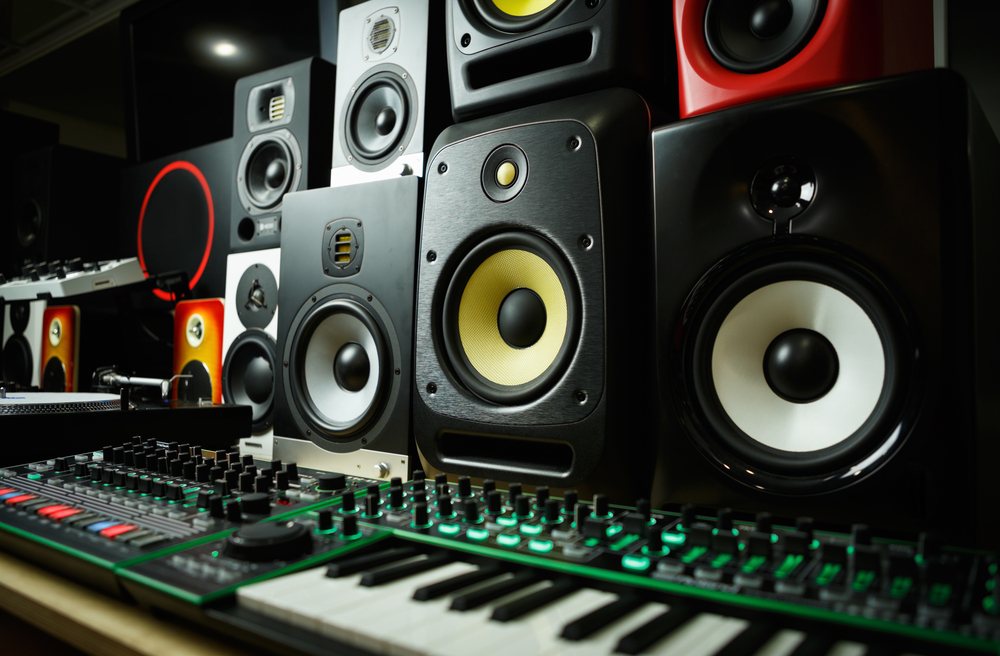
Bookshelf speakers can get crazy complex. With so many things to consider when buying a pair of speakers, it’s easy to get lost in the technical details. Since we’ve already covered a lot of the basics, we’re going to shift gears towards some practical advice.
Getting the Best Sound Quality out of Your Speakers
So you made the leap and bought a pair of high-quality speakers, but they just don’t sound as good as the raving reviews made them sound. What gives? Well, aside from the fact that reviews – especially on speakers – are highly subjective, there could be a multitude of different factors that are playing into your experience.
To help you get the best sound out of your speakers, you’ll want to do as much as you can to help bring out the best in your speakers. Now let’s get into it!
Break Your Speakers In
First things first; you’ll want to make sure you’ve broken your speakers in. When you fire up a brand-new pair of speakers, they can be stiff and rigid. This can mean that your speakers will actually sound worse when they’re brand new, with stiffer lows and mid’s.
By breaking speakers in, you allow the rubber surrounding the drivers and the spider to loosen up through use. This offers a more dynamic range, particularly on the bass driver, and can have appreciable differences in how your speakers will sound.
Typically, the recommended advice for break-in time is 100 audio hours, though that’s not a concrete number. You’ll want to use music that has a large dynamic range of sounds on both ends of the spectrum to properly break in your speakers.
Of course, not all speakers will produce an appreciable difference after breaking them in. However, you won’t really know until you try, and if you keep using them, you’ll find out if breaking them in makes a difference anyway.
Position Your Speakers Properly
Another great way to make sure you’re getting the best sound out of your speakers is to position them properly. While the setup of your room and where you want to put them will heavily dictate your options here, keep in mind that the placement of your speakers and other furniture can affect how you’ll perceive them to sound.
That’s because of the way acoustics work in a space. When dealing with acoustics, you’ve got two types of sound: direct sound and reflected sound.
Reflected sound can be both good and bad. Depending on your conditions, it may add a spacious ambiance that enhances your music experience. However, when it’s bad, it can make your bass sound muddy, make your mid’s and highs too harsh, or otherwise negatively impact your listening experience.
To ensure you’re getting the best sound out of your speakers, you want to get as much of the direct sound from them as possible. Do you have your speakers below where you normally sit when you listen to music? Consider picking up a set of speaker stands to raise them level with your head.
You should also factor in other things about your speakers as well. Are they bass-heavy rear-ported speakers? You might want to pull them away from the wall to give them room to breathe.
If you really want to take things to the extreme, you can add soundproofing to your walls to absorb and diffuse as much of the reflected sound in your room as you can. This probably isn’t necessary unless you’re listening to music in something like a garage or basement, but it certainly can’t hurt, and it’s not too hard or expensive either.
Pair Your Speakers With an Appropriate Amplifier
If you’re running a set of passive speakers, then you’ll want to ensure that you’re running them on an amplifier that’s a suitable match for the speakers. Running your speakers on an under-powered amp can cause clipping. Running on an overpowered amp can cause distortion if you feed the speaker too much power.
Both of these not only result in the loss of sound quality, they can also ruin your speakers in the long-run. This is why it’s important to pay attention to both your speakers’ and amp’s wattage ratings, to ensure they’re a good fit for one another.
Of course, there is room for error without significant repercussions. Just don’t expect to pair a high-end pair of speakers with a $20 amp without issues.
Use a Direct Connection
Perhaps one of the best ways to avoid audio quality issues and maximize the performance of your speakers is by hooking your audio source up to the speakers directly. Sure, Bluetooth is convenient. But it suffers from a lot of issues that can severely diminish the quality of your music.
Why? This is due in part to the fact that Bluetooth technology works on the 2.4GHz frequency band. This is the same band as Wi-Fi routers and other wireless devices, as well as other things like microwaves, car alarms, and baby monitors.
Combined with system-dependent Bluetooth features and the fact that many devices optimize Bluetooth for maximal power savings, it can lead to sound degradation that can diminish even a great pair of speakers down to a subpar listening experience.
Even our pick for the best Bluetooth bookshelf speakers, the Audioengine A2+ Wireless Speakers, which is equipped with the most advanced Bluetooth technology out of all speakers on the list, suffers from Bluetooth playback compared to a direct connection.
This is because the DAC unit built into the speakers only processes sound over USB, while audio over Bluetooth will miss out on the DAC unit’s processing and suffer from interference from other gadgets that utilize the 2.4GHz band.
Speaking of DAC units…
Adding a High-Quality DAC Unit or Sound Card to Your Setup
If you use digital devices to listen to your music, then you’re converting digital audio to analog. This is where a digital to analog conversion (DAC) unit comes into play.
You see, every device – from your laptop to your phone – comes with a built-in DAC unit, allowing your speakers to play music from them. However, in the case of devices such as phones and laptops, they generally come with a low-quality DAC unit, since sound processing is often just one small component of a much larger multi-functional system.
These low-quality DAC units can output lower bit rates than your music is encoded in or provide poor shielding against noise and electrical interference, especially on devices that don’t primarily market themselves as having high-quality audio output. Those alone can contribute to a poorer overall listening experience.
If you’re on a desktop computer, and you have an available PCI-e slot available on your motherboard, you may consider a sound card. Not only do they come with an onboard DAC and amplifier, but they’ll provide software features like software equalization. They also typically feature an expansive breadth of connectors, such as RCA and optical output, that most motherboards neglect to include.
For devices like phones and laptops, using a dedicated sound card isn’t an option. That’s where external DACs come into play. Like sound cards, they’ll offer enhanced audio in addition to greater flexibility, and process sound somewhere away from the otherwise noisy internal electronics of a computer.
They come in all sizes, and offer portability. This makes them great for all devices, and may be a more viable alternative to sound cards in a desktop, at the cost of software features.
Equalize Your Music
Equalization might be a dirty word for purists, but it can really help take your speakers the extra mile if they’re not quite doing it for you.
For instance, the Klipsch R-41M Bookshelf Home Speakers perform really well on highs, but they lack bass and mid’s. These speakers are high-quality and made from a reputable brand, so adding some equalization to pull back the highs or crank the mid’s and lows may help provide a better, more rounded sound overall.
Many audio players offer equalization, while stereo receivers and other hardware can also process the sound with equalization. Of course, equalization isn’t going to make a bad set of speakers sound great. But if the sound you’re getting from your speakers is too flat, or lacks somewhere on the spectrum, you might want to give it a shot.
For Those About to Rock (We Salute You)
We’ve covered most of the most pressing points of finding a good set of speakers, and how to get the most out of them. Now that you know what to look for, and you know how (and why) to optimize your setup, it’s time to rock out.

